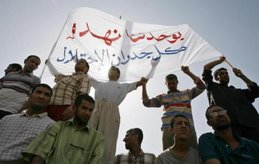Man-made catastrophe now 'as significant as Darfur'
By Mark Turner at the United Nations
Published: September 11 2007 03:00
Four years after a US-led invasion that was sold to the public partly on humanitarian grounds, Iraqis are suffering from a man-made catastrophe that is seen as compar-able in scope to the tragedy in Darfur.
The plight facing Iraqis "is as significant [as Darfur]", says Margarette Wahlstrom, deputy head of the UN's aid co-ordination arm Ocha. "It's the largest crisis of violence in a country against individuals."
Comparisons between emergencies are difficult, but in terms of displaced people alone, Iraq's crisis, with 4m displaced people, is twice as big as that of Darfur, the Sudan region currently experiencing serious ethnic violence. For Iraq to be described in similar terms as Sudan is striking testament to how bad the situation has become.
In early 2003, before US forces crossed the border from Kuwait, Iraqis may have thought things could not get much worse. A crippling conflict with Iran, followed by the first Gulf war and a decade of sanctions, had crippled the economy and left many millions dependent on food handouts.
But, anecdotally at least, the situation in mid-2007 is now even more dire than in 2003. "As far as children's living conditions go, they are worse now than immediately prior to the war," says Claire Hajaj, who works for Unicef, the children's agency, in Amman.
Oxfam, the international aid agency, said in a recent report that 8m Iraqis were in urgent need of emergency aid, while "many more are living in poverty, without basic services, and increasingly threatened by disease and malnutrition. If people's basic needs are left un-attended, this will only serve to further destabilise the country".
Iraqis are fleeing their homes in their millions in the largest Middle East population movement since the creation of Israel. Jennifer Pagonis, spokesperson for the UN refugee agency, says the monthly rate of displacement has reached more than 60,000 people.
More than 2m Iraqis are displaced inside Iraq, and struggling to survive. Syria estimates that it now hosts more than 1.4m Iraqis, while Jordan has between 500,000 and 750,000. Both countries' social services are overwhelmed, and even those Iraqi refugees who once had resources say their money is running out.
Unfortunately, what may now be the world's biggest human emergency is - by comparison with the global angst over Darfur - relatively unnoticed. A serious problem, aid workers say, is that rampant insecurity means international relief officials cannot go in and accurate numbers are almost imposs-ible to find.
Based in Amman, the UN's humanitarian operation relies mainly on local actors, who have reasons to massage the figures, and most official statistics date from 2005 and early 2006, before the bombing of an important Shia shrine in Samarra precipitated a new surge in secta-rian violence.
At that point, indicators broadly did not suggest that Iraqis were faring as badly as before the war. Nevertheless, even then a comprehensive survey published in May 2006 by the World Food Programme revealed that more than 4m people (15.4 per cent of the surveyed population) were food insecure and in dire need of various types of humanitarian assistance - 11 per cent higher than two years earlier.
The WFP is currently supporting a nationwide Food Security Survey; which should be ready by the first half of January 2008.
"Figures are hard to come by. We know that things have got worse particularly in the latter half of 2006 and first quarter of 2007, but we haven't got the stats to prove it," says Ms Hajaj.
"All we have is qualitative data from our field people, who report drug shortages in hospitals, long queues at the antenatal centres, curfews forbidding travel to hospital after dark, closed schools, frightened students and exhausted teachers."
What can be said is that Iraq's indicators are almost universally worse than those of its neighbours. Iraq's maternal mortality rates in 2004 were 1 in 65 deaths, compared with 1 in 130 for Syria and 1 in 450 for Jordan. Immunisation rates were 55 per cent, compared with 68 per cent in 2000 and 95 per cent and 99 per cent in Jordan and Syria respectively.
The UN estimates that only 30 per cent of the population has access to safe water, and with only 17 per cent of Iraq's sewage treated before release, the majority of Iraqis are living in unsanitary conditions - evidenced by a recent cholera outbreak in the north of the country.
According to Oxfam, only 60 per cent of the 4m Iraqis reliant on food aid have access to rations through the government-run Public Distribution System (PDS), down from 96 per cent in 2004. Forty-three per cent of Iraqis suffer from "absolute poverty", with more than half the population out of work.
It also claims child malnutrition rates have risen from 19 per cent before the US-led invasion in 2003 to 28 per cent now; while the number of Iraqis without access to adequate water supplies has risen from 50 per cent to 70 per cent since 2003.
Education is also in crisis. During the past year, the UN warns that many schools in the Baghdad, Anbar and Diyala areas were closed, and at least one in five children did not attend classes nationwide. In the south and north, teachers are struggling to accommodate displaced pupils who were able to re-enroll.
Copyright The Financial Times Limited 2007









